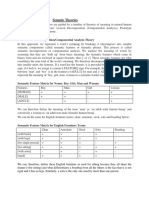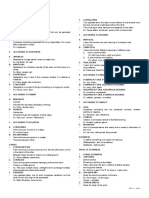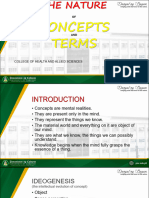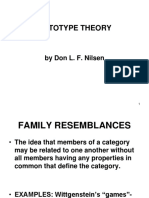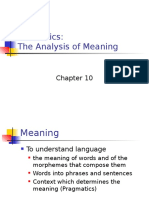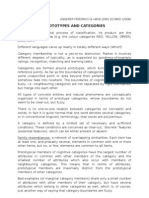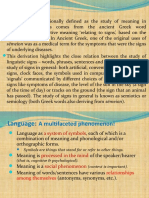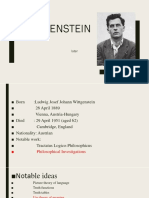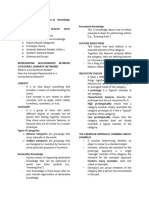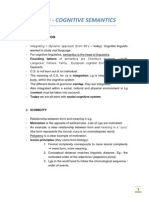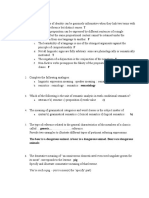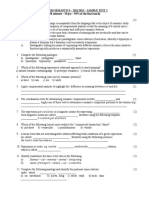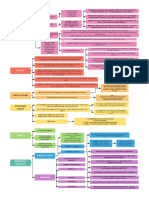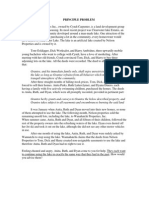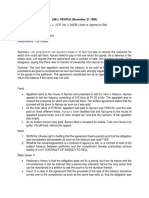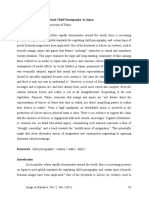Prototype-Based Approach
to Semantic Structure
# 14
�The specification of
meaning?
Decompositional approach
SEMANTIC DEFINITION a highly
specialized form of paraphrase based on
the distinctive components of the
particular meaning in question (Nida
1975)
e.g. cotton
<soft
substance|| which is white and
hair-like,
used to make cloth>
�Semantic tests for determining the semantic
components (the semes of a definition):
BUT- test and SO-test
He is an industrialist, but he is not rich.
He is an industrialist, so he is rich.
??He is an industrialist, but he is rich
??He is an industrialist, so he is not rich.
It's a bird, so it has wings.
??It's a bird, but it has wings.
....
�Semantic tests for determining the semantic
components (the semes of a definition):
HYPONYMY/ENTAILMENT:
X and other Ys
dolls and other ____________
cars and other ___________
pigeons and other ___________
striding and other ways of ___________
smirking and other ways of ____________
slapping and other ways of ____________
�Semantic tests for determining the semantic
components (the semes of a definition):
SEMANTIC ANOMALY TESTS
a) Tautology/Pleonasm
? The bouquet consisted of flowers
? The river flows
b) Paradox
That bachelor is a woman.
That gesture was magnanimous and egotistic.
c) Zeugma
Tom followed the road and the fox.
Bill and his passport expired.
You are free to execute your laws, and your citizens, as
you see fit.
�Semantic tests for determining the semantic
components (the semes of a definition):
COLLOCATIONS
For a collocation to be acceptable, collocates
must share a semantic component:
water runs [LIQUID SUBSTANCE]
to irrigate a(n) area, land, soil, field, garden,
lawn, meadow, pasture vs.
?to irrigate a
town square
[GROUND FOR GROWING PLANTS]
Cf. Hlebec (2010) - Semantic lexicon based
on a collocational method
�Semantic tests for determining the semantic
components (the semes of a definition):
FIXED METAPHORICAL EXPRESSIONS
make a pig of oneself
/EAT MUCH/
...
�Semantic definitions:
- Necessary and sufficient features?
- Boundaries?
bachelor
[HUMAN], [MALE], [ADULT], [NEVER MARRIED]
? John is a bachelor, since he is a 26-year-old man
who has never married.
? Marys husband is a real bachelor.
widow
[HUMAN], [FEMALE], [ADULT], [WAS MARRIED]
[HUSBAND DIED]
? Mary is a widow she killed her husband.
? Marys husband is a doctor. Her former husband
died yesterday, so she is a widow now.
�<a type of furniture || used for sitting, for
one person, with a back and visible legs>
���Ludwig Wittgenstein (1953),
Philosophical Investigations
Consider for example the proceedings that
we call games. I mean board-games, cardgames, ball-games, Olympic games, and so
on. What is common to them all? Dont say:
There must be something common, or they
would not be called games but look
and see whether there is anything common
to all.
�Wittgenstein: games
- Are they all amusing? Compare chess with
noughts and crosses. Or is there always winning
and losing, or competition between players? Think
of patience. In ball games there is winning and
losing; but when a child throws his ball at the wall
and catches it again, this feature has
disappeared. Look at the parts played by skill and
luck; and at the difference between skill in chess
and skill in tennis. Think now of games like ring-aring-a-roses; here is the element of amusement,
but how many other characteristic features have
disappeared!...
�Wittgenstein: games
For if you look at them you will not see
something that is common to all, but
similarities, relationships, and a whole
series of them at that.
Family resemblances
�William Labov (1973):
The Boundaries of Words and Their Meanings
cup, mug, bowl, vase
Experimental (picture-based) naming task
(varying shapes & contexts)
Fuzzy boundaries
No set of defining (necessary and sufficient)
features, but typical attributes (perceptual,
functional, interactional), which vary
depending on the situational context
�An alternative to checklist theories of
meaning Charles Fillmore (1975)
Instead of the meaning of a linguistic form
being represented in terms of a checklist of
conditions that have to be satisfied in order
for the form to be appropriately or truthfully
used, it is held that the understanding of
meaning requires, at least for a great many
cases, an appeal to an exemplar or
prototype.
�Prototype approach:
psychology linguistics
Eleanor Rosch 1970s
Exploring principles of categorization
Categorization one of the basic cognitive
processes concept formation and
organization
�Rosch experimental
studies
This study has to do with what we have in mind
when we use words which refer to categories
red - some reds are redder than others
dog to me a German shepherd is a very doggy
dog while a Pekinese is a less doggy dog
Categories examined: BIRD, FRUIT, VEGETABLE,
VEHICLE, TOOL, TOY, WEAPON, FURNITURE,
CLOTHING, SPORT
Goodness-of-example rating
Naming
Verification speed
�Goodness-of-example rating using a scale
from from 1 (= very good example) to 7 (=
very bad example, or not an example at all)
BIRD: robin, raven, ostrich, parrot, penguin,
sparrow...
VEHICLE: automobile, elevator, trailer,
skateboard, truck, subway...
FURNITURE: table, lamp, chair, shelf,
wastebasket, mirror...
WEAPON: gun, whip, ice pick, screwdriver,
knife, bottle...
FRUIT: apple, orange, fig, walnut, mango,
olive...
�Cf. Categorization
classical approach:
Aristotle ... Frege (predominant in Western
thought)
The laws of thought (axiomatic)
The law of identity: A A
The law of non-contradiction: (A A)
The law of the excluded middle: A A
Essence & accidence
Necessary and sufficient features
Category membership: 1 or 0
All members of a category have equal status
Categories have clear boundaries
�Categorization
prototype approach
Categories internally structured: prototype
(clearest case) + non-prototype members
ranging from better to poorer examples
Category membership: a matter of degree
Members of a category do not have equal
status
Categories have fuzzy boundaries
Eubild (The Heap Paradox) ... Wittgenstein
(family resemblances) ... Zadeh (fuzzy
logic)...
�Prototype approach
Prototype a cognitive reference point
Prototype approach accounts for itself
FURNITURE fuzzy boundaries, prototype
structure
BIRD clear boundaries, prototype structure
ODD NUMBER (2n + 1), necessary and
sufficient features, clear boundaries,
prototype effects
�Language and categorization
Language
- the instrument of categorization
cup/mug, chair/stool, tall/high,
hot/warm/cool/cold...
I love it / Im loving it
- the object of categorization
word, lexeme, noun, verb, sentence,
construction
nouniness (Ross 1973)
book, rich, refusal, refusing...
Cf. Gradience (Bolinger, Crystal, Quirk et al. ...)
�Linguistic means for expressing
(non-)prototypicality
HEDGES
(Lakoff 1972)
par excellence, sort of, kind of, basically, as it were, in
one sense, in a manner of speaking, strictly/loosely
speaking, in that ...
A pigeon is a bird par excellence
:
?A
penguin is a bird par excellence.
John killed Alice in that he did nothing to keep her alive.
? John killed Alice in that he murdered her.
, a wastebasket is a piece of furniture.
Fire! is a sentence
it expresses a
complete thought.
Cf. Hedges in pragmatics
�Linguistic means for expressing
prototypicality
REDUPLICATION
You make the fruit salad, and Ill make the
salad-salad.
Is she Canadian-French or French-French?
Are you a vegetarian-vegetarian?
I dont want this fat-free milk, I want milkmilk.
�Prototype semantics: lie
Coleman and Kay (1981)
speak untruthfully
(I) Moe has eaten the cake Juliet was
intending to serve to company. Juliet asks
Moe, 'Did you eat the cake?' Moe says, 'No.'
Did Moe lie?
(II) Dick, John, and Henry are playing golf.
Henry steps on Dick's ball. When Dick
arrives and sees his ball mashed into the
turf, he says, 'John, did you step on my
ball?' John replies, 'No, Henry did it.' Did
John lie?
�Prototype semantics: lie
(III) Peter believes he has to pass the candy store to get
to the pool, but he is wrong about this because the
candy store has moved. Peter's mother doesn't approve
of pool. As he is going out the door intending to go to
the pool, Peter's mother asks him where he is going. He
says, 'I am going by the candy store.' Did Peter lie?
(IV) One morning Kate has an arithmetic test she hasn't
studied for, so she doesn't want to go to school. She
says to her mother, 'I'm sick.' Her mother takes her
temperature, and it turns out to Kate's surprise that she
really is sick, later that day developing the measles.
Did Kate lie?
�Prototype semantics: lie
V) Schmallowitz is invited to dinner at his
boss's house. After a dismal evening
enjoyed by no one, Schmallowitz says to his
hostess, 'Thanks, it was a terrific party.'
Schmallowitz doesn't believe it was a terrific
party, and he really isn't trying to convince
anyone he had a good time, but is just
concerned to say something nice to his
boss's wife, regardless of the fact that he
doesn't expect her to believe it. Did
Schmallowitz lie?
�Prototype semantics: lie
(VI) John and Mary have recently started
going out together. Valentino is Mary's exboyfriend. One evening John asks Mary,
'Have you seen Valentino this week?' Mary
answers, 'Valentino's been sick with
mononucleosis the past two weeks.'
Valentino has in fact been sick with
mononucleosis for the past two weeks, but
it is also the case that Mary had a date with
Valentino the night before. Did Mary lie?
�Prototype semantics: lie
VII) Two patients are waiting to be wheeled
into the operating room. The doctor points
to one and says, 'Is Jones here the
appendectomy or the tonsillectomy?
Nurse Braine has just read the charts, but
she has mixed them up and replies, 'The
appendectomy, when in fact poor Jones is
the one scheduled for tonsillectomy. Did
Nurse Braine lie?
�Prototype semantics: lie
(VIII) Superfan has got tickets for the
championship game. He shows them to his
boss, who says, 'Listen, Superfan, any day
you don't come to work, youd better have a
better excuse than that.' Superfan says, 'I
will.' On the day of the game, Superfan calls
in and says, 'I can't come to work today, Boss,
because I'm sick.' Ironically, Superfan was
really sick when he said he was
(stomachache), and he did not go to the
game. Did Superfan lie?
�Prototype semantics
Prototype of lie:
- falsity
- intent to speak falsely
- intent to deceive
HW: Consider a prototype analysis of:
mother, brother, love, cold...
word,
sentence, prefix...
�Prototype approach to semantic
structure
Cognitive linguistics
A fruitful model of polysemy:
a
polysemous linguistic unit a category of
senses organized around a prototype (to
be revisited)
Principles of categorization & semantic
structure (to be revisited)
�Prototype approach
challenges:
Identifying the semantic prototype and
other category members?
The nature of relations between senses?
Prototypicality and frequency?























